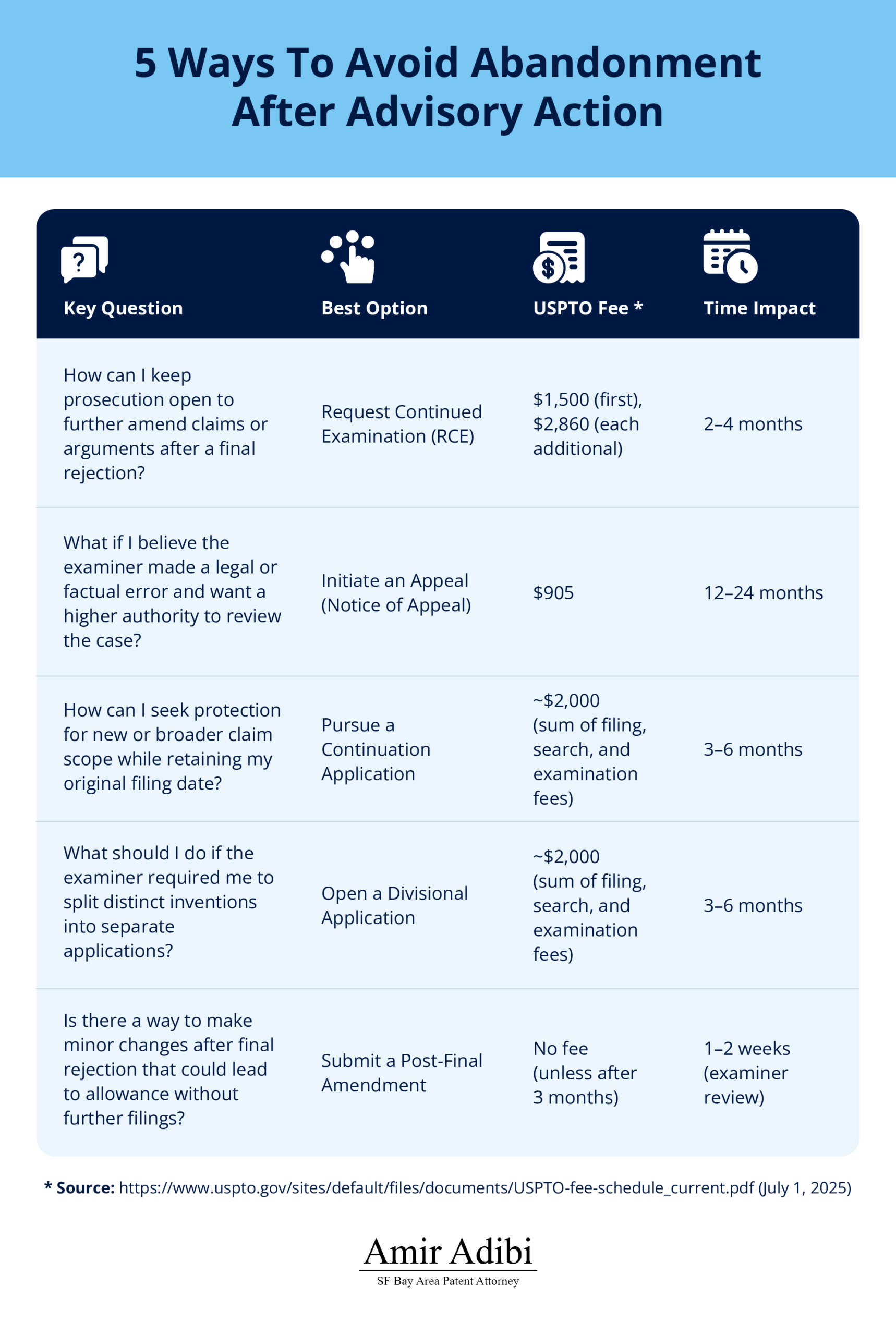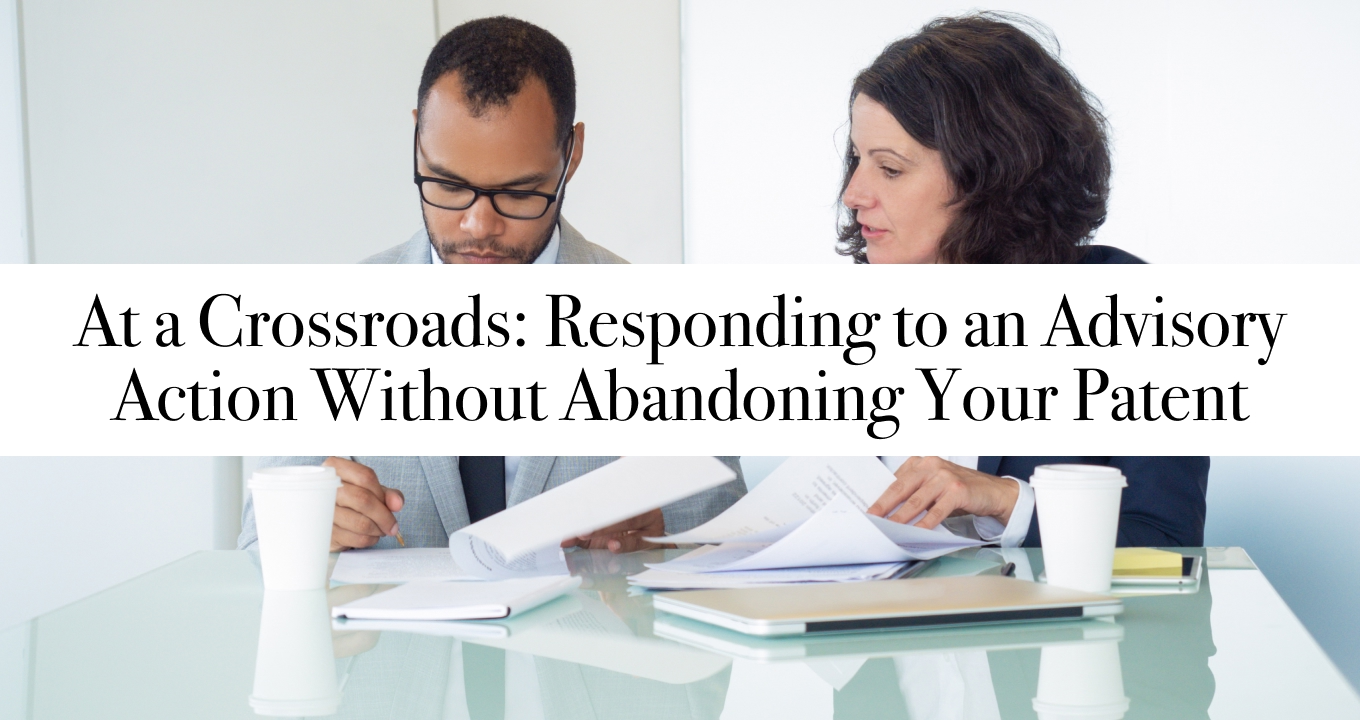You’ve followed every rule. Now an Advisory Action lands, and suddenly the future of your patent feels uncertain—even jeopardized. That moment when your application could vanish is stressful. But with the right strategy—whether to file an RCE, appeal, continuation, or petition—you can safeguard your innovation and avoid abandonment after advisory action before the 6‑month deadline.
If you’re wondering how long the application will abandon after receiving advisory action, the short answer is: six months from the final rejection date, not the Advisory Action date.
Key Takeaways
- The six-month response window starts on the Final Office Action (final rejection) date—not the Advisory Action date.
- Timely filings—RCEs, appeals, amendments—keep your application alive.
- If abandonment happens, revival is possible if the delay was unintentional.
Definition And Purpose Of Advisory Actions
An Advisory Action is the USPTO’s formal feedback after you respond to a final patent rejection without resolving it fully. It confirms that your after‑final amendments or arguments didn’t tip the scale toward allowance.
The examiner uses this notice to:
- Confirm whether your amendments will be entered.
- Notify you that your after‑final response failed to overcome the rejection.
- Prompt you toward next steps—filing an RCE, lodging an appeal, or submitting a continuation.
An Advisory Action doesn’t extend your deadline; it merely highlights that the clock from the Final Office Action is still running.
Advisory Action In The Patent Prosecution Timeline
Picture your prosecution timeline like a highway with clearly marked exits:
| Event | Timeframe |
| Final Office Action | Day 0 |
| Response without fee (SSP) | Day 90 |
| Likely Advisory Action* | Day 90–120 |
| Statutory abandonment deadline | Day 180 |
The USPTO generally issues an Advisory Action within 1–2 weeks after you file your response to a patent rejection. It confirms your amendments didn’t shift the application toward allowance. But your priority is the six‑month statutory deadline—this never pauses. Failing to act during this timeframe leads to abandonment after advisory action, a serious procedural setback. The sooner you decide your route—RCE, appeal, or petition—the better.
The Abandonment Risk Following An Advisory Action
An Advisory Action shines a light on your application’s fragility. If you miss the six‑month deadline without submitting a valid action (like RCE, appeal, or continuation), the USPTO will declare your application abandoned—immediately and without warning. This is how many inventors accidentally face abandonment after advisory action.
How Long the Application Will Abandon After Receiving Advisory Action
Under 35 U.S.C. 133, if you don’t take action within six months of the final rejection, the USPTO considers the application abandoned. No second notice. No grace period.
Advisory Actions don’t stop that clock. Yet many applicants mistakenly assume they do, and that misconception leads to one of the most costly patent application mistakes. The only thing that counts is whether you’ve taken valid steps—like filing an RCE or starting an appeal—before the six-month window closes.
Common Misconceptions About Advisory Actions And Abandonment
One of the most frequent misconceptions is not understanding how long the application will abandon after receiving advisory action. Plenty of applicants assume an Advisory Action gives them extra time. That’s not true. The Action just responds to your latest move—it doesn’t delay the deadline.
Another mistake is relying on informal communication or planning to “follow up later.” That won’t cut it. Only formal, accepted responses preserve your rights. These are avoidable patent application mistakes, but they require careful tracking and awareness of USPTO timelines.
Think of Advisory Actions as a signal, not a shield. They tell you what didn’t work—but they don’t buy you time to figure out what will.
Calculating The Critical Abandonment Date
Pinpointing your deadline is simple:
- Find the mailing date on the Final Office Action.
- Add six calendar months.
- Adjust if the deadline falls on a weekend or federal holiday to the next business day.
For example, a Final Office Action dated January 15, 2025, means that without action, your application abandons on July 15, 2025.
Legal Framework Governing Advisory Actions
You must respond to patent rejection within six months of the Final Office Action’s mailing, as outlined in 35 U.S.C. 133. The Advisory Action reinforces that statutory clock; it doesn’t reset it.
What You Can File
- Request For Continued Examination (RCE): Submit a new argument or claim amendment, and prosecution reopens. USPTO ensures a 50% fee reduction for small entities for first RCEs.
- Notice of Appeal: Takes the matter to PTAB, followed by an appeal brief within two months.
- Continuation/Divisional: File a separate application with adjusted claim scope, retaining original priority.
- Post-final Amendment (1.116): Limited further amendments may be possible even after a final rejection.
Courts consistently uphold the USPTO’s strict timing rules — a single missed deadline can seal your application’s fate.

Preventing Abandonment After Receiving An Advisory Action
You still have options—each strategy depending on your position and examiner feedback.
Request For Continued Examination (RCE)
Filing an RCE resets prosecution, lets you amend claims, and provides a fresh record.
- Pros: Opens the door for improved argument and new evidence.
- Cons: USPTO charges $1,500 (first RCE, large entity) and $2,860 thereafter (as of July 1, 2025).
- Best Use: When you can strengthen the record without appealing.
Notice Of Appeal
You can progress to PTAB if you believe the examiner fundamentally erred.
- Pros: Places your case before judges; suitable when strong legal grounds exist.
- Cons: Longer process (often 12–24 months) and appeal can cost $900+ plus attorney fees.
- Best Use: When errors in law or fact are undeniable and impactful.
Continuation Or Divisional Applications
File a continuation to pursue additional or modified claims based on your original disclosure, or a divisional to protect distinct inventions identified by a USPTO restriction requirement.
- Pros: Lets you pursue new or distinct claims from your original filing while keeping the parent’s priority date and strategic flexibility.
- Cons: Require separate filings and fees, and can add complexity to your prosecution process.
- Best Use: When you want new coverage or need more prosecution time.
Petition Options
If a viable option failed due to technicality or extraordinary circumstance, certain petitions may help restore your rights.
1. Petition to Revive for Unintentional Delay:
- Pros: Most common and effective way to regain rights after missing a deadline; straightforward if the delay was truly unintentional.
- Cons: Requires a formal statement, a significant petition fee, and prompt action—delays can weaken your case.
- Best Use: When you missed a deadline by oversight or error and want to restore your application.
2. Petition to Withdraw Holding of Abandonment
- Pros: Can quickly reverse abandonment if you have proof of timely filing; no admission of fault on your part.
- Cons: Requires strong documentary evidence and may involve back-and-forth with the USPTO if evidence is unclear.
- Best Use: When abandonment is due to USPTO error, not your own missed deadline.
3. Petition for Rule Waivers (37 CFR 1.183)
- Pros: May provide relief when no other remedy is available and justice requires it.
- Cons: Rarely granted; must show extraordinary circumstances and pay a petition fee.
- Best Use: When you face a unique hardship, such as a natural disaster or USPTO system failure, and no standard petition applies.
Petitions can provide a last resort if you miss a critical deadline or face an unusual barrier. However, they are not substitutes for timely action. If you believe you need to file a petition, consult with a patent attorney to maximize your chances of success.
Responding To An Advisory Action Effectively
Your response requires precision in both form and strategy.
Evaluating The Examiner’s Position
Break down the Advisory Action in detail:
- What amendments were entered?
- Which rejections stand?
- Map each rejection to a counterpoint in your specification.
Strategic Considerations For Response Timing
Be aware:
- RCE can buy you breathing time.
- Appeal is decisive—don’t aim for compromise.
- Continuation offers claim diversification.
Crafting The Appropriate Response
Depending on your choice:
- RCE: Include robust claim amendments directly tied to examiner’s concerns.
- Appeal: Focus on specific legal shortcomings in examiner’s rationale backed by case law or PTAB precedent.
- Continuation: Present entirely new claims that sidestep current rejections.
Whichever path you choose, make sure you’re taking formal steps to respond to patent rejection effectively and within USPTO deadlines. After‐final responses can use the After Final Consideration Pilot (AFCP 2.0) to get extra examiner review without RCE.
Best Practices To Avoid Abandonment After Advisory Action
Stay ahead with proactive systems:
- Proactive docketing: Track final rejects and 6-month deadlines, with layered reminders at 5, 4, and 3 months.
- Communication logs: EFS-Web receipts, examiner emails, and internal notes should be centralized.
- Examiner interviews: Clarify where your response missed the mark—30 minutes can replace months.
- Review team: For Advisory Actions, gather your IP team bi-weekly to determine the right path, check fee accuracy, and validate filings.
Stay informed on how long the application will abandon after receiving advisory action so you can act early. Many inventors lose years of work due to simple patent application mistakes like misreading deadlines. Understanding the real risk of abandonment after advisory action could be the difference between protecting your invention or watching it disappear.
When in doubt, respond to patent rejection decisively, and don’t leave anything to chance. Consider partnering with Amir Adibi, your Bay Area patent advocate who blends technical precision with tactical prosecution. Schedule a consultation to protect your patent investment, craft a roadmap tailored to your Advisory Action outcome, and preserve what’s uniquely yours.

